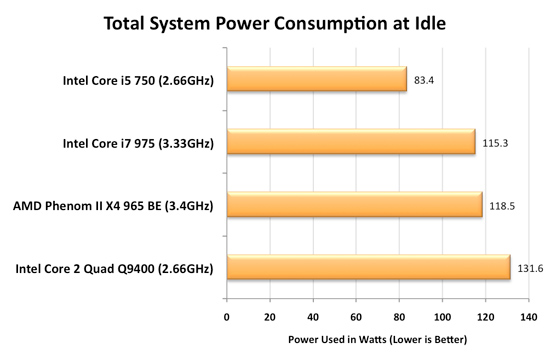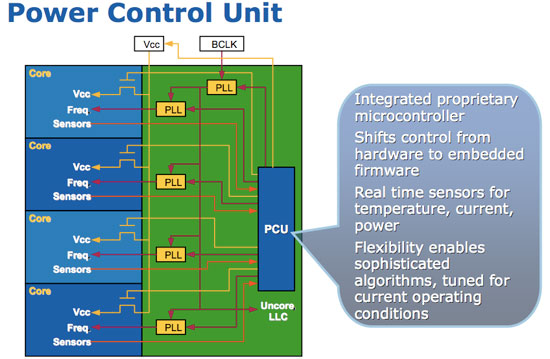Intel's Core i7 870 & i5 750, Lynnfield: Harder, Better, Faster Stronger
by Anand Lal Shimpi on September 8, 2009 12:00 AM EST- Posted in
- CPUs
Homework: How Turbo Mode Works
AMD and Intel both figured out the practical maximum power consumption of a desktop CPU. Intel actually discovered it first, through trial and error, in the Prescott days. At the high end that's around 130W, for the upper mainstream market that's 95W. That's why all high end CPUs ship with 120 - 140W TDPs.
Regardless of whether you have one, two, four, six or eight cores - the entire chip has to fit within that power envelope. A single core 95W chip gets to have a one core eating up all of that power budget. This is where we get very high clock speed single core CPUs from. A 95W dual core processor means that individually the cores have to use less than the single 95W processor, so tradeoffs are made: each core runs at a lower clock speed. A 95W quad core processor requires that each core uses less power than both a single or dual core 95W processor, resulting in more tradeoffs. Each core runs at a lower clock speed than the 95W dual core processor.
The diagram below helps illustrate this:
| Single Core | Dual Core | Quad Core | Hex Core | |
| TDP |  |  |  |  |
| Tradeoff |  |  |  |  |
The TDP is constant, you can't ramp power indefinitely - you eventually run into cooling and thermal density issues. The variables are core count and clock speed (at least today), if you increase one, you have to decrease the other.
Here's the problem: what happens if you're not using all four cores of the 95W quad core processor? You're only consuming a fraction of the 95W TDP because parts of the chip are idle, but your chip ends up being slower than a 95W dual core processor since its clocked lower. The consumer has to thus choose if they should buy a faster dual core or a slower quad core processor.
A smart processor would realize that its cores aren't frequency limited, just TDP limited. Furthermore, if half the chip is idle then the active cores could theoretically run faster.
That smart processor is Lynnfield.
Intel made a very important announcement when Nehalem launched last year. Everyone focused on cache sizes, performance or memory latency, but the most important part of Nehalem was far more subtle: the Power Gate Transistor.
Transistors are supposed to act as light switches - allowing current to flow when they're on, and stopping the flow when they're off. One side effect of constantly reducing transistor feature size and increasing performance is that current continues to flow even when the transistor is switched off. It's called leakage current, and when you've got a few hundred million transistors that are supposed to be off but are still using current, power efficiency suffers. You can reduce leakage current, but you also impact performance when doing so; the processes with the lowest leakage, can't scale as high in clock speed.
Using some clever materials engineering Intel developed a very low resistance, low leakage, transistor that can effectively drop any circuits behind it to near-zero power consumption; a true off switch. This is the Power Gate Transistor.

On a quad-core Phenom II, if two cores are idle, blocks of transistors are placed in the off-state but they still consume power thanks to leakage current. On any Nehalem processor, if two cores are idle, the Power Gate transistors that feed the cores their supply current are turned off and thus the two cores are almost completely turned off - with extremely low leakage current. This is why nothing can touch Nehalem's idle power:

Since Nehalem can effectively turn off idle cores, it can free up some of that precious TDP we were talking about above. The next step then makes perfect sense. After turning off idle cores, let's boost the speed of active cores until we hit our TDP limit.

On every single Nehalem (Lynnfield included) lies around 1 million transistors (about the complexity of a 486) whose sole task is managing power. It turns cores off, underclocks them and is generally charged with the task of making sure that power usage is kept to a minimum. Lynnfield's PCU (Power Control Unit) is largely the same as what was in Bloomfield. The architecture remains the same, although it has a higher sampling rate for monitoring the state of all of the cores and demands on them.
The PCU is responsible for turbo mode.










343 Comments
View All Comments
goinginstyle - Thursday, September 10, 2009 - link
What is worthless here is your continued ramblings about subjects you have no actual knowledge of right now. Do you own a P55 system? If so, let's see an article from you. Really, you come over spouting off and calling everyone idiots, yet, you we do not see any articles from you at Toms about the subject matter. In fact, we do not see any comments from you anywhere else about P55. Toms, Tech Report, and AT all came to the same conclusion, presented the same type of information (although AT discussed subjects like PCIE), and yet you do not comment on those other websites.Either you are posting here because you think your negative posts will somehow get you attention that your mother never gave you or you are doing to try and look important to the people in charge at Toms. I hope to God that they never allow you to post another piece of garbage on their site. Really, that article was a straight copy and paste from several other articles on the subject along with Wikipedia information. I am surprised you were not sued for plagiarism, maybe you were and that is why you are over here.
So far, all of your ramblings have only proved your total lack of intelligence when it comes to computer components. Once again, when will we see you making comments on Toms about their similar coverage or when can you expect to see your expert PP article on the site?
eternalfantasy - Tuesday, September 8, 2009 - link
Fully agree up to the AMD part. This is the most biased review I've seen published by Anandtech to date. I think a "Buy me now!" link at the end of the article with an Intel sponsored Ad will complete the article perfectly.Stock clock speed CPU review is what highstreet mags for average Joes write about. Excluding what's importent for readers of tech sites, such as:
Clock for clock comparison
Maximum overclock with similer priced CPU/platform
is just blatent attempt at glorifying Intel's mainstream platform to look like more then what it really is. A cheaper mainstream alternative to the X58 that has been avaliable over a year ago.
PassingBy - Tuesday, September 8, 2009 - link
As released, Core i5 and 1156 Core i7 have no IGP market, so presumably people reading this review will have no interest in using an IGP.In any case, we can safely say that your prognostications like 'a brain dead platform for brain dead people' were total bullshit, as many people tried to tell you. Now, many more people can place a Nehalem-based system on their list of possible purchases. Clarkdale will extend Nehalem/Westmere to even lower price points (and yes, then you can start comparing IGPs, if you like).
TA152H - Tuesday, September 8, 2009 - link
You're really confused.Honestly, anyone who knows anything about computers would be pretty stupid to get this platform. It's fine stock, but when you throw in overclock, the i7 920 is the better choice.
But, here's your hypocrisy. This article was main for mainstream people, since there's no overclocking comparisons, really. The IGP is what makes AMD work, and they do sell their processors into this market. Anand was commenting on how AMD had to lower their prices, so within this context the entire market is applicable. You didn't understand the context, did you?
I didn't say the platform was brain-dead, although you seem to be. I said it was brain-damaged. It's a Celeron. If you look at the reviews from better sites, you can see the Bloomfield running at the same speed is faster than the brain-damaged Lynnfield. Anand really tried to obfuscate this, by using bad comparisons or those meant to show the Lynnfield in the best light, instead of just presenting the most useful information. He fooled you, because you're a moron, but not everyone.
I do like this site, or I did, but I'm really getting unnerved by the way they test to show what they want to show, instead of test and then make up their minds. It's really problematic, and it's going to bite them when more people figure this out.
imperialsoren - Tuesday, September 8, 2009 - link
You have a nasty way of conversing.IdolObserver - Wednesday, September 9, 2009 - link
It's not only his nasty way of conversing. He also doesn't have a clue what he is talking about.Zymon - Tuesday, September 8, 2009 - link
I agree in the main part - there are many aspects which seem to have been completely ignored in this, and many other reviews of Lynnfield.It seems strange that you haven't used a level playing field between compared systems: ALL 3 platforms can use DDR3 - you've used X48 for Core 2 chips, but apparently used different RAM than i5. Why on earth have you used an AM2+ board and DDR2 ram for AMD? I guess it's *only* been 9 months since AM3 became available?
As mentioned, a true clock-for-clock comparison would be VERY interesting, using the same RAM, at the same speeds and timings between platforms.
Anand Lal Shimpi - Tuesday, September 8, 2009 - link
Sorry if this wasn't made clear in the review but the Phenom II X4 965 BE used the same test platform as our review of that CPU: an AM3 motherboard with DDR3 memory.I'm out of the office now but I'll update the test tables later this evening to reflect this.
Take care,
Anand
Zymon - Tuesday, September 8, 2009 - link
Cheers for the clarification Anand!- It seemed unusual for one of your articles, hence the comment!
Laters..
snakeoil - Tuesday, September 8, 2009 - link
i want to know if those benchmarks were with the turbo enabled, which would be cheating, because that's overclocking.for every benchmark turbo must be disabled to be fair.
readers are not stupid.